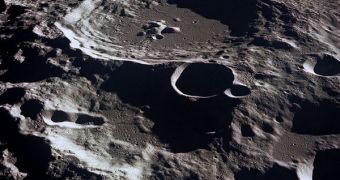Over the past few years, the Moon has been scanned from all directions by a swathe of spacecraft and other scientific instruments, in a bid to create either high-detail maps, or to determine the most likely location in which water-ice exists. As NASA was investigating possible sites to crash its LCROSS mission into, it found that the temperatures inside the natural satellite's permanently shadowed craters were some of the lowest in the solar system. Now, new LRO data not only confirm that, but show that the temperatures are even lower than first recorded, Nature News reports.
According to the new information relayed back by the Lunar Reconnaissance Orbiter (LRO), the lowest temperature inside such a shadowed crater can go as low as 26° Kelvin (-249° Celsius), which is well below the freezing point of nitrogen, at 63° Kelvin (-210.0° Celsius). “Nothing like this has ever been measured in the Solar System. One would probably have to travel far beyond the Kuiper Belt to find an object whose temperatures are this low,” University of California in Los Angeles (UCLA) planetary scientist David Paige explains. The expert is also the principal investigator for the spacecraft's temperature-sensing instrument.
NASA also revealed that the new measurements were carried out in October, when the northern regions of the Moon were in mid-winter. The satellite has a very small axial tilt, about 20 times less than the Earth. This means that its seasons are not very pronounced. However, planetary scientists say that there are some small regions at the poles where the Sun does not rise for more than six months, just like on our planet. These special regions were the targets of the October LRO investigation.
Similar formations, called “cold traps,” were also discovered at the south pole. They are only about 20° Celsius warmer than their northern counterparts, even in the dead of summer. “We now have a good idea of what all the temperatures (both minimum and maximum) are at the cold traps, which will help us understand what volatile [compounds] they may contain,” Paige explains. “There could be all kinds of interesting compounds trapped there,” the expert has said at the annual meeting of the American Geophysical Union, held in San Francisco.

 14 DAY TRIAL //
14 DAY TRIAL //